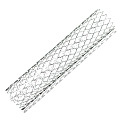(Angioplasty, Percutaneous Transluminal Coronary Angioplasty, PTCA, Balloon Angioplasty)

An example of an angioplasty stent.
Angioplasty is a procedure that treats atherosclerosis by opening clogged arteries in the heart. During this procedure, a small balloon is inserted to stretch open a clogged artery. A small metal coil called a stent can be combined with this procedure to keep the artery open.
- are having an heart attack
- have blockage on one or more of your coronary arteries that puts you at risk for a heart attack
- are healthy enough to have the procedure
- have frequent or severe chest pain that doesn't respond to medication
- have reduced blood flow to areas of your heart
This procedure improves blood flow to the heart, leading to lessened symptoms such as chest pain or shortness of breath. This procedure is done in a hospital by a heart specialist (cardiologist) and a team of specialized nurses and technicians. It may be repeated if necessary.
Risks and precautionsCoronary balloon angioplasty is usually a straightforward and safe procedure. However, there are some risks of complications or side effects, including:
- bleeding or bruising at the site where the balloon is inserted
- blood clots at the site of angioplasty
- damage to heart valve or blood vessel
- death
- heart attack
- infection
- irregular heartbeat
- kidney problems
- reactions to the anesthetic, X-ray dye, or medications
- re-narrowing of the artery
- stroke
It is important that you understand all the risks of complications and side effects of an angioplasty, and what you or your doctor can do to avoid them. Make sure that your doctor is aware of all your concerns.
Get immediate medical assistance if you experience any of the following symptoms after the angioplasty:
- bleeding or pain at the place where the catheter was inserted
- signs of infection such as fever or swelling, redness or discharge where the catheter was inserted
- chest pain
- shortness of breath
- unusual weakness
Some people may experience complications or side effects other than those listed. Check with your doctor if you notice any symptom that worries you after your procedure.
During the testThis procedure is usually performed by a cardiologist in a hospital setting under local anesthesia (i.e., you will be awake during the angioplasty). The entire procedure often takes anywhere from 30 minutes to a few hours, depending on how many blocked arteries you have.
- You will have an intravenous (IV) in your arm to give you fluids and medications during the angioplasty. You may be given pain and anticlotting medications before the procedure.
- Electrodes will be put on your chest to monitor your heart.
- After you are given a local anesthetic, your doctor will make a very small incision in your groin to allow a catheter attached to the balloon to enter the artery. When the catheter is inserted, you may feel pressure in your groin.
- A small amount of dye is injected through the catheter to help your doctor guide the catheter and locate the clogged artery using live X-ray.
- After your doctor locates the blockage, the balloon will be inflated to open the clogged artery. When the balloon is inflated, you may feel chest pain. It may be kept there for a few minutes to stretch the artery wall before it is removed.
- After the artery is widened, a collapsed stent may be inserted along with the balloon.
- Once the stent is opened by the inflated balloon, it will stay in place to keep the artery open.
- The balloon will then be collapsed and removed.
Before the testIt is important that you fully understand what an angioplasty involves beforehand. Ask your doctor to explain the risks, benefits, and drawbacks of an angioplasty, and don't be shy to probe further until you are comfortable with your doctor's responses.
Your doctor will first conduct a special X-ray test with contrast dye called a coronary angiogram to determine where the blockage is. In addition, a blood test and an electrocardiogram may be performed.
You may not be able to eat or drink before the procedure; follow the timing that your doctor recommends. In general, people are advised to not eat for 8 hours before the procedure; and most hospitals ask that you do not drink or eat anything after midnight the night before the procedure.
If you are taking any prescription or over-the-counter (non-prescription) medications, supplements, or herbal products, make sure you inform your doctor or pharmacist. Ask them whether it is necessary for you to stop taking any of these medications and products before the procedure. It is also important to tell them if you have allergies to certain medications, bandages, latex, or have other medical conditions.
Plan to have someone drive you home after the angioplasty.
After the testYou will likely stay in the hospital for 1 to 2 days and have your heart condition monitored. Your doctor may also prescribe you medications to prevent blood clots and relax the arteries in your heart. You should be able to return to your normal daily activities in one week.
Once you return home, be sure to drink plenty of water to wash out the contrast dye used. You should also refrain from intense exercise and heavy lifting for a few days.
To maintain the positive results from the procedure, you should commit to positive lifestyle changes such as quitting smoking, maintaining a healthy weight, and exercising regularly.

An example of an angioplasty stent.